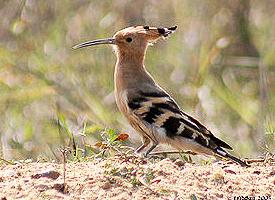
Stav ohrožení
| Vyhynulý |
Popis zvířete
The Saint Helena Hoopoe (Upupa antaios) was a remarkable and now-extinct species of bird that was once native to the island of Saint Helena in the South Atlantic Ocean. This bird belonged to the Upupidae family, which includes all the hoopoe species, known for their distinctive crown of feathers and long, tapering bills. The Saint Helena Hoopoe, however, was a unique member of this family, both in size and appearance, setting it apart from its more familiar relatives found in Europe, Asia, and Africa.Physical Characteristics:
The Saint Helena Hoopoe was considerably larger than the common hoopoe (Upupa epops), making it one of the most distinctive features of this bird. It had a robust body and an impressive wingspan that allowed it to maneuver with grace and agility through its island habitat. Its plumage was described as being richly colored, with a combination of warm browns, creams, and blacks, which not only provided it with camouflage among the island’s foliage but also made it a sight to behold.
One of the most striking features of the Saint Helena Hoopoe was its crest, a common trait among hoopoes. This crest consisted of a fan of feathers that could be erected or laid flat on the head, depending on the bird’s mood or intentions. The crest likely played a role in courtship displays and territorial disputes, adding to the bird’s charismatic presence.
Diet and Behavior:
The diet of the Saint Helena Hoopoe primarily consisted of insects and larvae, which it would forage from the ground using its long, curved bill to probe into the soil. This feeding behavior was essential for the bird’s survival, allowing it to extract food sources from deep within the ground that other species could not reach.
Little is known about the breeding habits of the Saint Helena Hoopoe, but it is believed that, like its relatives, it nested in cavities, possibly in cliffs or among rocks, where it would lay its eggs and raise its young away from predators.
Extinction:
The extinction of the Saint Helena Hoopoe is a tragic story that mirrors the fate of many island species worldwide. Its decline was primarily due to human activities, including habitat destruction and the introduction of invasive species that competed for resources or directly preyed upon the hoopoe. By the 16th century, this magnificent bird had vanished, leaving behind only a few descriptions and records that hint at its former glory.
Legacy:
Today, the Saint Helena Hoopoe is remembered as a symbol of the fragility of island ecosystems and the devastating impact humans can have on native wildlife. Its extinction serves as a poignant reminder of the importance of conservation efforts to protect the remaining species that call our planet’s islands home.
In conclusion, the Saint Helena Hoopoe (Upupa antaios) was a unique and beautiful bird that once graced the island of Saint Helena. Its extinction is a loss not only to biodiversity but also to the natural heritage of the island. As we reflect on the story of the Saint Helena Hoopoe, it compels us to consider our relationship with the natural world and the steps we must take to preserve it for future generations.
Mapa výskytu

Podobná zvířata
Nové fotografie zvířat
Top 10 zvířat
- Dolphin gull (Leucophaeus scoresbii)
- Diana monkey (Cercopithecus diana)
- Moustached guenon (Cercopithecus cephus)
- Galápagos tortoise (Geochelone nigra complex)
- Stone loach (Barbatula barbatula)
- Japanese macaque (Macaca fuscata)
- Greek tortoise (Testudo graeca)
- Russian tortoise (Testudo horsfieldii)
- Common flying dragon (Draco volans)
- Galápagos penguin (Spheniscus mendiculus)
